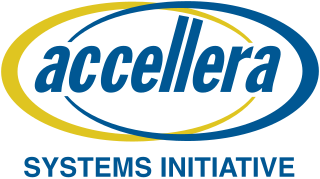Related Research Articles
Mentor Graphics is a US-based electronic design automation (EDA) multinational corporation for electrical engineering and electronics, headquartered in Wilsonville, Oregon. Founded in 1981, the company was acquired by Siemens in 2017. Since 2021, the former Mentor Graphics operates as a division at Siemens named Siemens EDA.
Electronic design automation (EDA), also referred to as electronic computer-aided design (ECAD), is a category of software tools for designing electronic systems such as integrated circuits and printed circuit boards. The tools work together in a design flow that chip designers use to design and analyze entire semiconductor chips. Since a modern semiconductor chip can have billions of components, EDA tools are essential for their design; this article in particular describes EDA specifically with respect to integrated circuits (ICs).

Accellera Systems Initiative (Accellera) is a standards organization that supports a mix of user and vendor standards and open interfaces development in the area of electronic design automation (EDA) and integrated circuit (IC) design and manufacturing. It is less constrained than the Institute of Electrical and Electronics Engineers (IEEE) and is therefore the starting place for many standards. Once mature and adopted by the broader community, the standards are usually transferred to the IEEE.

Silvaco Inc. develops and markets electronic design automation (EDA) and technology CAD (TCAD) software and semiconductor design IP (SIP). The company is headquartered in Santa Clara, California, and has a global presence with offices located in North America, Europe, and throughout Asia. Since its founding in 1984, Silvaco has grown to become a large privately held EDA company. The company has been known by at least two other names: Silvaco International, and Silvaco Data Systems.
Daisy Systems Corporation, incorporated in 1981 in Mountain View, California, was a computer-aided engineering company, a pioneer in the electronic design automation (EDA) industry.
MKS, Inc is a subsidiary of PTC, Inc. It was previously a multinational independent software vendor that was acquired by Parametric Technology Corporation on May 31, 2011. MKS operated in the Application Lifecycle Management (ALM) and Systems Administration market segments.

8x8 Inc. is an American provider of Voice over IP products. Its products include cloud-based voice, contact center, video, mobile and unified communications for businesses. Since 2018, 8x8 manages Jitsi.
Dassault Systèmes Simulia Corp. is a computer-aided engineering (CAE) vendor. Formerly known as Abaqus Inc. and previously Hibbitt, Karlsson & Sorensen, Inc., (HKS), the company was founded in 1978 by David Hibbitt, Bengt Karlsson and Paul Sorensen, and has its headquarters in Providence, Rhode Island.

ON Semiconductor is an American semiconductor supplier company, formerly in the Fortune 500, but dropping into the Fortune 1000 in 2020. Products include power and signal management, logic, discrete, and custom devices for automotive, communications, computing, consumer, industrial, LED lighting, medical, military/aerospace and power applications. ON Semiconductor runs a network of manufacturing facilities, sales offices and design centers in North America, Europe, and the Asia Pacific regions. Headquartered in Phoenix, Arizona, ON Semiconductor has revenues of $3.907 billion (2016), which puts it among the worldwide top 20 semiconductor sales leaders.

Cadence Design Systems, Inc., headquartered in San Jose, California, is an American multinational computational software company, founded in 1988 by the merger of SDA Systems and ECAD, Inc. The company produces software, hardware and silicon structures for designing integrated circuits, systems on chips (SoCs) and printed circuit boards.
Stratavia, formerly known as ExtraQuest, was a software company that specialized in enterprise Database and Data Center Automation, and private cloud computing enablement. Stratavia was founded by Venkat Devraj and Rainier Luistro in 2001.
PathWave Design is a division of Keysight Technologies that was formerly called EEsof. It is a provider of electronic design automation (EDA) software that helps engineers design products such as cellular phones, wireless networks, radar, satellite communications systems, and high-speed digital wireline infrastructure. Applications include electronic system level (ESL), high-speed digital, RF-Mixed signal, device modeling, RF and Microwave design for commercial wireless, aerospace, and defense markets.
AWR Corporation is an electronic design automation (EDA) software company, formerly known as Applied Wave Research, and then acquired by National Instruments
Sigrity, acquired by Cadence Design Systems in 2012 for $80M.[1][2], supplies software for IC package physical design and for analyzing power integrity, signal integrity and design stage electromagnetic interference (EMI). Analysis is performed on chips, IC packages and printed circuit boards.
Protecode was a private company based in Ottawa, Ontario, Canada that provided open source license and security management software used for software development license compliance.
Siemens Digital Industries Software is an American computer software company specializing in 3D & 2D Product Lifecycle Management (PLM) software. The company is a business unit of Siemens, operates under the legal name of Siemens Industry Software Inc, and is headquartered in Plano, Texas.
Amalto Technologies S.A. is a software development company based in Paris, France. The company develops and operates business-to-business (B2B) document exchange software solutions and provides system integration services. It serves the oil & gas, industrial, environmental and enterprise markets.
Power integrity or PI is an analysis to check whether the desired voltage and current are met from source to destination. Today, power integrity plays a major role in the success and failure of new electronic products. There are several coupled aspects of PI: on the chip, in the chip package, on the circuit board, and in the system. Four main issues must be resolved to ensure power integrity at the printed circuit board level:
- Keep the voltage ripple at the chips pads lower than the specification
- Control ground bounce
- Control electromagnetic interference and maintain electromagnetic compatibility: the power distribution network is generally the largest set of conductors on the circuit board and therefore the largest (unwanted) antenna for emission and reception of noise.
- Maintaining a proper DC Voltage level at the load at high currents. A modern processor or field-programmable gate array can pull 1-100 Amps at sub-1V VDD levels with AC and DC margins in the tens of millivolts. Very little DC voltage drop can thus be tolerated on the power distribution network.
Switching Control Techniques address electromagnetic interference (EMI) mitigation on power electronics (PE). The design of power electronics involves overcoming three key challenges:
- power losses
- EMI
- harmonics
References
- ↑ "Electromagnetic Simulation".
- ↑ "Accelerated Method of Moments" (PDF).
- ↑ "nWave".
- ↑ "nApex".
- ↑ "nVolt".
- ↑ "nCloud".
- ↑ "Gartner Names Physware as 2010 Cool Vendor in Semiconductors". Wireless News. 2010-05-30.
- ↑ "Mentor Graphics Acquires Nimbic, Inc". mentor.com (Press release). May 20, 2014. Retrieved 2015-02-07.
- ↑ Corp, Mentor Graphics. "Mentor Graphics Acquires Nimbic, Inc". www.prnewswire.com. Retrieved 2021-04-01.